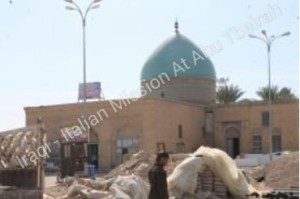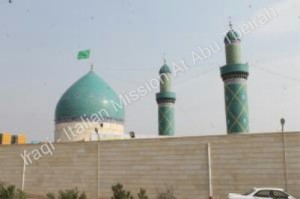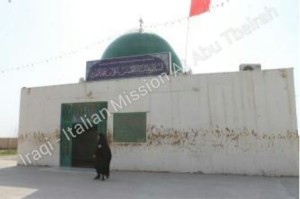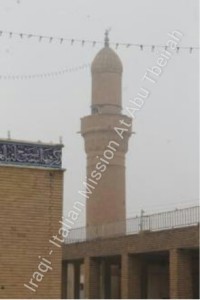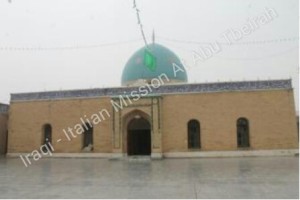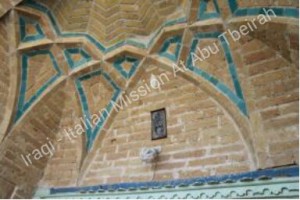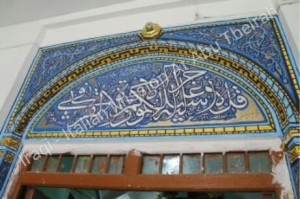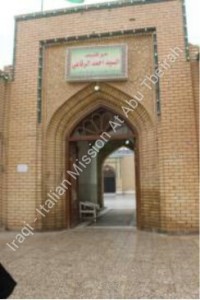Today we will discuss the other sites in the region of Maysan, to have a general framework.
Shrine of prophet Al Uzair
The shrine of Al-Uzair, the Arabic for the Prophet Ezra of the Ancient Testament, is located 65 km from Amara. The importance of the shrine beyond the religious aspect is mainly due to its location on the side of the Tigris, which was a major commercial root in all times. In its present state the shrine preserve of the Ottoman period (250 years ago) :
• the decorations of the façade of shrine and of the separate synagoge
• the inner columns
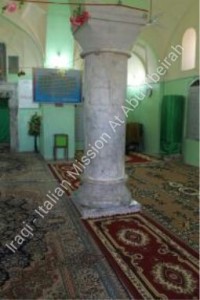
• some reliefs with Jewish inscriptions decorating the inner of the shrine
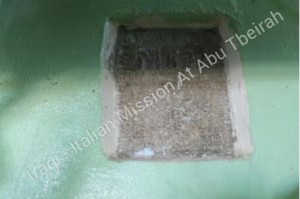
• the wooden carved sarcophagus covering the grave of the Prophet.
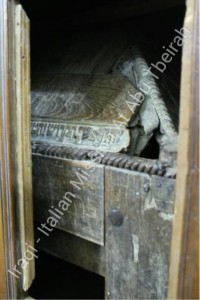
From the historical point of view it is interesting to stress that this shrine, although being Muslim today, was used by the Jews until the ’50s of the last century.
Shrine of Ali al Sharqi
The Shrine is religiously one of the most important of Maysan and one of the most important of the Shi’a. The building has been edified 150 years ago but in its present status shows numerous restoration that altered the original structures. In 2008 the two minarets have been built.
There is a strong influence from Iran both in the shape and in the decoration of the shrine:
• the sarcophagus which was a present of Persia in 1886;
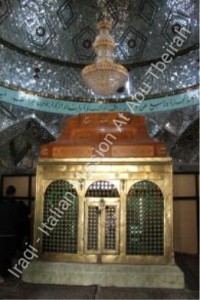
• The crystal ceilings of the dome;
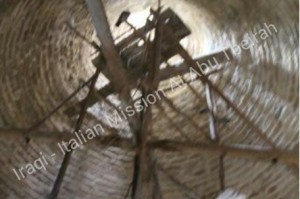
• The minarets (which resemble those of Isfahan in Iran).
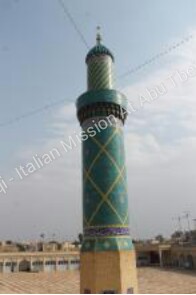
The site is frequented by many pilgrims coming from at the Shi’a world and is surely one of the main religious attraction of the Province.
Shrine of Ali al Gahrbi
If compared with the Ali al Sharqi’s Shrine that of Ali al Gahrbi one is of lesser religious and artistic significance. The shrine, according to the legend of the locals, was built by the British army after that its General was recovered by an illness through a visit to the former shrine, during the World War 1 (1915). The shrine has no touristic appeal even if the open area where it lays can be of a certain interest for the tourists looking for landscape.
Said Ahmad Ar-Rufa’i
The Shrine lays to 60 km ca from Amara and to 22 km of the district city of Rufa’i. From a religious point of view, the little mosque is venerated mainly by the Sunni believers, being Said Ahmed a Derwish. The mosque present the same structure of all the other shrines visited, with a great court encircling the main building inside which the grave of the venerated saint can be found. The building itself, which was edified by the Ottomans in the late sixth century, presents very few original part (practically, only the minaret is still in place, while all the rest of the building, entrance door and windows included, is modern; the pavement of the court has been replaced very recently).
The graves of some important sheikhs of the last 150 years are buried here (also the founder of the city of Nasiriyah, Nasir Al-Sadoon).
Oggi tratteremo degli altri siti presenti nella regione di Maysan, per aver un quadro generale.
Santuario di profeta Al Uzair
Il santuario di Al-Uzair, arabo per il Profeta Ezra dell’Antico Testamento , si trova a 65 km da Amara. L’importanza del santuario oltre per l’aspetto religioso è dovuto principalmente alla sua posizione sulla riva del Tigri, che è stata una grande radice commerciale in tutti i tempi. Allo stato attuale il santuario conserva del periodo ottomano (250 anni fa):
• le decorazioni della facciata del santuario e della sinagoga separata
• le colonne interne

• alcuni rilievi con iscrizioni ebraiche che decorano l’interno del santuario

• un sarcofago in legno intagliato che copre la tomba del Profeta.

Dal punto di vista storico è interessante sottolineare che questo santuario, pur essendo musulmano oggi, è stato utilizzato dagli ebrei fino agli anni ’50 del secolo scorso.
Santuario di Ali al Sharqi
Il Santuario è dal punto di vista religioso uno dei più importanti di Maysan e uno dei più importanti della Shi’a. L’edificio è stato edificato 150 anni fa, ma nel suo stato attuale mostra numerosi interventi di restauro che ha alterato le strutture originali. Nel corso del 2008 sono stati costruiti i due minareti. C’è una forte influenza dall’Iran sia nella forma che nella decorazione del santuario:
• il sarcofago, che è stato un regalo di Persia nel 1886;

• I soffitti di cristallo della cupola;

• I minareti (che ricordano quelli di Isfahan in Iran).
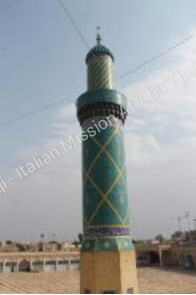
Il sito è frequentato da molti pellegrini provenienti dal mondo della Shi’a a ed è sicuramente uno dei principali attrazione religiosi della Provincia.
Santuario di Ali al Gharbi
Se confrontato con il Santuario di Ali al Sharqi quello di Ali al Gahrbi è di minore significato religioso e artistico. Il santuario, secondo la leggenda degli abitanti, è stato costruito dall’esercito britannico dopo che il suo generale è stato salvato da una malattia attraverso una visita all’ex Santuario, durante la prima Guerra Mondiale (1915). Il santuario non ha fascino turistico, anche se l’area aperta dove esso si stabilisce può essere di un certo interesse per i turisti in cerca di paesaggio.
Said Ahmad Ar-Rufa’i
Il Santuario è situato a 60 km circa da Amara e a 22 km della città-distretto di Rufa’i. Da un punto di vista religioso, la piccola moschea è venerata soprattutto dai fedeli sunniti, essendo Said Ahmed un Dervish. La moschea presenta la stessa struttura di tutti gli altri santuari visitati, con una grande corte che circonda l’edificio principale all’interno del quale si può trovare la tomba del santo venerato . L’edificio, che è stato edificato dagli Ottomani nel tardo secolo sesto, presenta pochissima parti originali (in pratica, solo il minareto è in piedi, mentre tutto il resto dell’edificio, porta d’ingresso e le finestre incluse, è moderna, il pavimento del tribunale è stato sostituito poco tempo fa).
Le tombe di alcuni importanti sceicchi degli ultimi 150 anni sono sepolti qui (anche il fondatore della città di Nassiriya, Nasir Al-Sadun).
